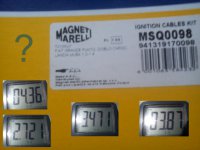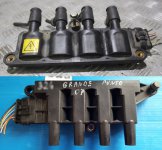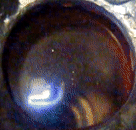Quick guide ("3 in 1"), spark plugs, leads, coils. How to check/replace.
0. Remove air filter box/assembly. Watch out (in yellow - two rubber hoses, don't break 'em).
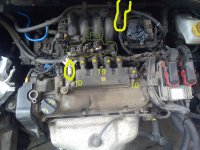
1. Remove and clean (dust, mud, oil) ignition coil-pack module/unit.

2. Ignition cables, (high voltage, "high tension") leads are fragile, delicate.
Using pliers like this is a good idea. Rubber likes to seize on spark plugs.
Never pull on cables, damage guaranteed (& for example rough idle after spark plugs change).
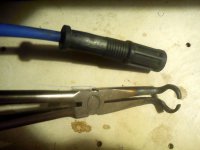
3. Some leads are marked, numbered. If you are reusing old ones, check this (and mark yourself).

4. Do not attempt spark plugs change job if you are not able to clean the engine around old plugs. Air compressor is ideal. If you don't own one, rinse plug pockets/cavities with brake-cleaner (fresh can has fairly high pressure stream), put some small hose, straw, whatever, on the nozzle/tip as an extension to really get there.

5. To undo the plugs you'll need 16 mm hex socket, but extended, long one. Doesn't have to be "special" posh one for spark plugs (with rubber grommet/insert, to hold/retain the plug). Plugs can be seized, don't be afraid to use some force (torque) or "jerk" it (but, be moderate).
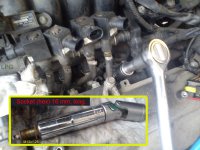
6. Old plugs. Almost a textbook example of good (used) sparkplugs. Proper combustion process (no obvious problems like black soot, oil, etc.). But gap was too big (1,3-1,4 mm range). That means: little too much mileage.

7. Brand new plugs come pre-gapped, in 0,8-1,0 mm range (depends on maker, Denso, NGK, Bosh, etc.). There is a resistor built-in, for NGK value is 5 kilo ohms. You should check both (gap and resistance), "just in case".
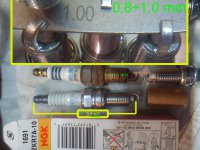
8. Be careful where you check your numbers (like torque specs). Some service manuals, etc., are misleading. This is an example (so called "eLearn"). My Grande (8-valves) has M12 thread plugs (not M14, like many older FIAT engines from "FIRE" family). Check that if you can, before you order the sparkplugs. Normally, you don't use any lubrication around ignition system (I know, there are anti-seize compounds for thread, and insulating silicone grease for leads rubber boots). Use one, if you really need it, and know what you're doing.

9. How to judge engine condition by sparkplugs look/appearance. Example. Back in the days, B.I. (Before Internet) there were books. Now you have similar charts on-line. If you want to know more, find one (Google)...

10. Spark plugs are resistive. Leads too. Forgot to measure new leads, but old ones were in 200-300 ohms range. More important thing is, that all leads are close, similar readings. When one is clearly "off", and/or readings jump all over the place when you measure (move leads, bend them), it's "shot". Replace complete set.
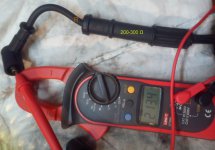
11. Coil-pack module has 4 independent coils ("transformers").
► Low voltage side (primary) has common positive lead (pin 1).
► High voltage (secondary) has common ground (pin 6).
No service manual ever mentions internal diodes...maybe first batch had none, they added this in later coil unit models(?). Who knows...

12. So, if you have such coils, you can NOT check the secondary side resistance. Ohm-meter will tell you "break", "open" circuit (no continuity). High voltage diodes are there to suppress unwanted small spark that is generated when coil is switched ON. Coils produce sparks when there is any CHANGE of the EM field (that's the true principle of the operation).
► www hella com/techworld/uk/Technical/Car-electronics-and-electrics/Ignition-coil-2886/
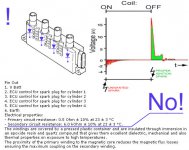
13. To detect presence of such diode(s) you can perform simple tests at home. First is voltage check. You'll need some source, DC, voltage level doesn't matter much, let's say 5-25 V range. Mains power supply (DC) or battery. Most important thing is to limit the current! Voltmeter must be digital exactly for that reason. It has so called "high input impedance", typically 1 Mega ohm and more (like 10 M). Remember, coil is high voltage, but low current on secondary side. You can kill it with...continuous low voltage source (at first glance, that "doesn't make sense", but it's just the way it is).
So, if you connect in right polarity (according to schematic below and coils layout - image number 11), you should see your voltage source (roughly). If not, there really is a open circuit (but try to flip polarity anyway).
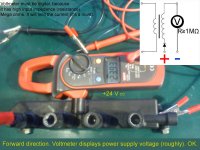
14. Flip polarity (swap leads) on your source. Now it should be "no reading" ideally - in reality there can be small negative voltage (diodes are not perfect, they "leak" in reverse) or your multimeter will keep auto-ranging. That's OK (good sign).
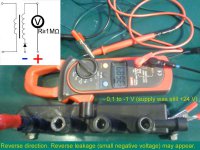
15. Similar test, same idea, and schematic. If you don't own voltmeter. You can substitute it with LED and resistor (remember, you must limit current somehow), a few kilo (ohms) for example. LED's are sensitive and start to glow in micro-amps range. This time you flip polarity only on the coils (LED will light on, only in one direction, so you don't change polarity on LED and battery, those elements stay coupled correct way - you want to prove that coli has diode, not that LED is one directional).
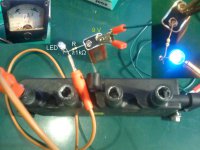
16. No voltmeter, no batteries, no resistors. Mains AC supply test. To limit the current (again), you can use screwdriver type voltage probe (neon bulb with resistor). Put live ("hot", phase) wire into common ground pin, and probe on high voltage side. Instead of completing circuit by touching the probe end directly, again, use LED. If module is good, LED will glow only in one direction (when you hold it by one of the legs, not the other one). If there are diodes inside coils (of course check all 4), they must perform rectifying action. Of course be careful, shock hazard.
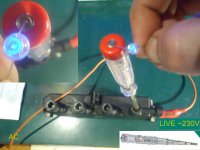
17. For electronics hobbyists. You can feed small AC signal into any side of the coil, and watch the other. If there is a diode, it must rectify (make "DC").

18. If you are not familiar with electricity do not try to make real sparks using coils-pack from the car. You can overload it, kill it, etc. Plus safety...
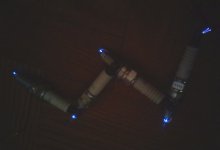
If you want to know more, check this YouTube channel: Photonicinduction
19. Finally, you can not fully check plugs, leads and coils at home, and be 100% sure that everything is fine perfectly. Important factors are: real load (electrical) and (high) operating temperature. No easy way to mimic this at home. Old-school methods like spraying water can actually cause, initiate the failure (not help to find, diagnose one).
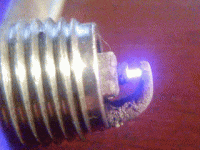
========= The End =========
0. Remove air filter box/assembly. Watch out (in yellow - two rubber hoses, don't break 'em).

1. Remove and clean (dust, mud, oil) ignition coil-pack module/unit.

2. Ignition cables, (high voltage, "high tension") leads are fragile, delicate.
Using pliers like this is a good idea. Rubber likes to seize on spark plugs.
Never pull on cables, damage guaranteed (& for example rough idle after spark plugs change).

3. Some leads are marked, numbered. If you are reusing old ones, check this (and mark yourself).

4. Do not attempt spark plugs change job if you are not able to clean the engine around old plugs. Air compressor is ideal. If you don't own one, rinse plug pockets/cavities with brake-cleaner (fresh can has fairly high pressure stream), put some small hose, straw, whatever, on the nozzle/tip as an extension to really get there.

5. To undo the plugs you'll need 16 mm hex socket, but extended, long one. Doesn't have to be "special" posh one for spark plugs (with rubber grommet/insert, to hold/retain the plug). Plugs can be seized, don't be afraid to use some force (torque) or "jerk" it (but, be moderate).

6. Old plugs. Almost a textbook example of good (used) sparkplugs. Proper combustion process (no obvious problems like black soot, oil, etc.). But gap was too big (1,3-1,4 mm range). That means: little too much mileage.

7. Brand new plugs come pre-gapped, in 0,8-1,0 mm range (depends on maker, Denso, NGK, Bosh, etc.). There is a resistor built-in, for NGK value is 5 kilo ohms. You should check both (gap and resistance), "just in case".

8. Be careful where you check your numbers (like torque specs). Some service manuals, etc., are misleading. This is an example (so called "eLearn"). My Grande (8-valves) has M12 thread plugs (not M14, like many older FIAT engines from "FIRE" family). Check that if you can, before you order the sparkplugs. Normally, you don't use any lubrication around ignition system (I know, there are anti-seize compounds for thread, and insulating silicone grease for leads rubber boots). Use one, if you really need it, and know what you're doing.

9. How to judge engine condition by sparkplugs look/appearance. Example. Back in the days, B.I. (Before Internet) there were books. Now you have similar charts on-line. If you want to know more, find one (Google)...

10. Spark plugs are resistive. Leads too. Forgot to measure new leads, but old ones were in 200-300 ohms range. More important thing is, that all leads are close, similar readings. When one is clearly "off", and/or readings jump all over the place when you measure (move leads, bend them), it's "shot". Replace complete set.

11. Coil-pack module has 4 independent coils ("transformers").
► Low voltage side (primary) has common positive lead (pin 1).
► High voltage (secondary) has common ground (pin 6).
No service manual ever mentions internal diodes...maybe first batch had none, they added this in later coil unit models(?). Who knows...

12. So, if you have such coils, you can NOT check the secondary side resistance. Ohm-meter will tell you "break", "open" circuit (no continuity). High voltage diodes are there to suppress unwanted small spark that is generated when coil is switched ON. Coils produce sparks when there is any CHANGE of the EM field (that's the true principle of the operation).
► www hella com/techworld/uk/Technical/Car-electronics-and-electrics/Ignition-coil-2886/

13. To detect presence of such diode(s) you can perform simple tests at home. First is voltage check. You'll need some source, DC, voltage level doesn't matter much, let's say 5-25 V range. Mains power supply (DC) or battery. Most important thing is to limit the current! Voltmeter must be digital exactly for that reason. It has so called "high input impedance", typically 1 Mega ohm and more (like 10 M). Remember, coil is high voltage, but low current on secondary side. You can kill it with...continuous low voltage source (at first glance, that "doesn't make sense", but it's just the way it is).
So, if you connect in right polarity (according to schematic below and coils layout - image number 11), you should see your voltage source (roughly). If not, there really is a open circuit (but try to flip polarity anyway).

14. Flip polarity (swap leads) on your source. Now it should be "no reading" ideally - in reality there can be small negative voltage (diodes are not perfect, they "leak" in reverse) or your multimeter will keep auto-ranging. That's OK (good sign).

15. Similar test, same idea, and schematic. If you don't own voltmeter. You can substitute it with LED and resistor (remember, you must limit current somehow), a few kilo (ohms) for example. LED's are sensitive and start to glow in micro-amps range. This time you flip polarity only on the coils (LED will light on, only in one direction, so you don't change polarity on LED and battery, those elements stay coupled correct way - you want to prove that coli has diode, not that LED is one directional).

16. No voltmeter, no batteries, no resistors. Mains AC supply test. To limit the current (again), you can use screwdriver type voltage probe (neon bulb with resistor). Put live ("hot", phase) wire into common ground pin, and probe on high voltage side. Instead of completing circuit by touching the probe end directly, again, use LED. If module is good, LED will glow only in one direction (when you hold it by one of the legs, not the other one). If there are diodes inside coils (of course check all 4), they must perform rectifying action. Of course be careful, shock hazard.

17. For electronics hobbyists. You can feed small AC signal into any side of the coil, and watch the other. If there is a diode, it must rectify (make "DC").

18. If you are not familiar with electricity do not try to make real sparks using coils-pack from the car. You can overload it, kill it, etc. Plus safety...

If you want to know more, check this YouTube channel: Photonicinduction
19. Finally, you can not fully check plugs, leads and coils at home, and be 100% sure that everything is fine perfectly. Important factors are: real load (electrical) and (high) operating temperature. No easy way to mimic this at home. Old-school methods like spraying water can actually cause, initiate the failure (not help to find, diagnose one).

========= The End =========


